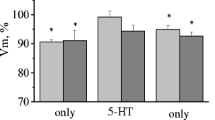Abstract
The activity of 109 neurons in the compact and diffuse zones of the pedunculopontine nucleus was studied in freely mobile rabbits during the acquisition and performance of a defensive operant conditioned reflex. A total of 47% of the neurons recorded showed responsive properties to the conditioned stimulus, which is evidence for the involvement of the pedunculopontine nucleus in operant learning. A significant predominance of excitatory conditioned reflex responses to the conditioned stimulus was demonstrated, showing that the nature of the influence of the pedunculopontine nucleus on projection structures during learning is mostly excitatory. The main patterns of cell responses to the conditioned stimulus were identified, these reflecting the nature of the influence of the conditioned stimulus on neuron activity, the structure of the behavioral act, and the properties of the reinforcement, suggesting a relationship between the pedunculopontine nucleus and the processes of attention, motor learning, and reinforcement. A significant decrease in the reactivity of neurons in the pedunculopontine nucleus to the conditioned stimulus as a result of specialization due to learning was demonstrated. Differences in the associative reactive properties of the compact and diffuse zones of the pedunculopontine nucleus to the conditioned stimulus were identified, which is evidence for the functional heterogeneity of this formation and suggests a leading role for the cholinergic compact zone in operant defensive behavior.
Similar content being viewed by others
REFERENCES
K. A. Bykhovskii and V. I. Maiorov, “A discriminator for extracting spikes of defined shape under visual control,” Zh. Vyssh. Nerv. Deyat., 37, No. 4, 785 (1987).
Yu. Konorskii, The Integrative Activity of the Brain [in Russian], Mir, Moscow (1970).
V. A. Korshunov, “A compact micromanipulator for chronic extracellular recording of neuron activity in fixed and freely mobile animals,” Biol. Nauki, No. 5, 103 (1989).
B. I. Kotlyar, V. I. Maiorov, N. O. Timofeeva, and V. V. Shul'govskii, Neuronal Organization of Conditioned Reflex Behavior [in Russian], Nauka, Moscow (1983).
B. I. Kotlyar, N. O. Timofeeva, and I. I. Semikopnaya, “Dynamics of hippocampal neuron activity during formation of a conditioned avoidance reflex,” Zh. Vyssh. Nerv. Deyat., 31, No. 3, 521 (1981).
B. I. Kotlyar, N. O. Timofeeva, and L. D. Popovich, “Conditioned reflex switching: neurophysiological mechanisms,” Vestn. Mosk. Gos. Univ. Ser. 16, Biologiya, No. 2, 3 (1985).
R. Naatanen, Attention and Brain Function [in Russian], Moscow State University Press, Moscow (1998).
A. Bechara and D. Van der Kooy, “A single brainstem substrate mediates the motivational effects of both opiates and food in nondeprived but not in deprived rats,” Behav. Neurosci., 106, 351 (1992).
S.E. Brauth and J. Olds, “Midbrain unit activity during classical conditioning,” Brain Res., 134, 73 (1977).
H. Conde, J. F. Dormont, and D. Farin, “The role of the pedunculopontine tegmental nucleus in relation to conditioned motor performance in the cat. II. Effects of reversible inactivation by intracerebral microinjections,” Exptl. Brain Res., 121, No. 4, 411 (1998).
F. Dellu, W. Mayo, J. Cherkaoni, et al., “Learning disturbances following excitotoxic lesion of cholinergic pedunculopontine nucleus in the rat,” Brain Res., 544, 126 (1991).
J. F. Dormont, H. Conde, and D. Farin, “The role of the pedunculopontine tegmental nucleus in relation to conditioned motor performance in the cat. I. Context-dependent and reinforcementrelated single unit activity,” Exptl. Brain Res., 121, No. 4, 401 (1998).
E. Fifkova and J. Marsala, “Stereotaxic atlases for the cat, rabbit and rat,” in: Electrophysiological Methods in Biological Research, J. Bures, M. Petran, and J. Zachar (eds.), Academic Press, New York (1967).
F. Florio, A. Capozzo, E. Puglielly, et al., “The function of the pedunculopontine nucleus in the preparation and execution of an externally-cued bar pressing task in the rat,” Behav. Brain Res., 104, 95 (1999).
E. Gracia-Rill, “The pedunculopontine nucleus,” Progr. Neurobiol., 36, 363 (1991).
W. Inglis, J. S. Dunbar, and P. Winn, “Outflow from the nucleus accumbens to the pedunculopontine tegmental nucleus: dissociation between locomotor and the acquisition of the responding for conditioned reinforcement stimulated by d-amphetamine,” Neurosci., 62, 51 (1994).
M. Kock, “The neurobiology of startle,” Progr. Neurobiol., 59, 107 (1999).
M. Lepore and K. B. Franclin, “N-methyl-D-aspartate lesion of the pedunculopontine nucleus blocks acquisition and impairs maintenance of responding reinforced with brain stimulation,” J. Neurosci., 71, 147 (1996).
M. Matsumara, K. Watanabe, and Ch. Ohye, “Single-unit activity in the primate nucleus tegmenti pedunculopontinus related to voluntary arm movement,” Neurosci. Res., 28, No. 2, 155 (1997).
M. M. Mesulam, E. J. Mufson, B. H. Wainer, and A. J. Levey, “Central cholinergic pathways in the rat: an overview based on an alternative nomenclature (Ch1-Ch6),” Neurosci., 10, 1185 (1983).
G. Moruzzi and H. W. Magoun, “Brain stem reticular formation and activation of the EEG,” EEG Clin. Neurophysiol., 1, 459 (1949).
J. P. Pascoe and B. S. Kapp, “Electrophysiology of the dorsolateral mesopontine reticular formation during Pavlovian conditioning in the rabbit,” J. Neurosci., 54, No. 3, 753 (1993).
M. J. Olds and J. Olds, “Unit activity: motivation-dependent responses from midbrain neurons,” Science, 165, 1269 (1966).
W. Schultz, “Predictive reward signal of dopamine neurons,” J. Neurophysiol., 80, 1 (1998).
T. Steckler, W. Inglis, Ph. Winn, and A. Sahgal, “The pedunculopontine tegmental nucleus: a role in cognitive processes?” Brain Res. Rev., 19, No. 3, 298 (1994).
R. F. Thompson, T. W. Berger, C. F. Cegavske, et al, “The search for the engram,” Amer. Psychol., 31, No. 2, 209 (1976).
Author information
Authors and Affiliations
Rights and permissions
About this article
Cite this article
Ivlieva, N.Y., Timofeeva, N.O. Neuron Activity in the Pedunculopontine Nucleus during an Operant Conditioned Defensive Reflex. Neurosci Behav Physiol 33, 499–506 (2003). https://doi.org/10.1023/A:1023419418869
Issue Date:
DOI: https://doi.org/10.1023/A:1023419418869



